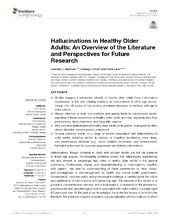| dc.description.abstract | Studies suggest a substantial minority of healthy older adults have hallucinatory experiences, in line with existing evidence on hallucinations in other age groups, though it is still unclear if hallucination prevalence increases or declines with age in older cohorts. Stigma attached to both hallucinations and ageing leads to considerable under-reporting of these experiences in healthy older adults and may negatively bias how professionals, family members, and the public respond. Why and when hallucinations in healthy older adults remit, persist, or progress to other clinical disorders remains poorly understood. Current evidence points to a range of factors associated with hallucinations in older adults including decline in sensory or cognitive functioning, poor sleep, and psychosocial stressors (e.g., social isolation, loneliness, and bereavement), highlighting the need for accurate assessment and tailored interventions. Hallucinations, though common in youth and younger adults, are not the preserve of these age groups. Accumulating evidence shows that hallucinatory experiences are also present at surprisingly high rates in healthy older adults in the general community. Furthermore, stigma and misunderstanding of hallucinations, together with ageism, may lead to under-reporting of these experiences by older adults, and misdiagnosis or mismanagement by health and mental health practitioners. Consequently, improved public and professional knowledge is needed about the nature and significance of hallucinations with advancing age. The purpose of this review is to provide a comprehensive overview, and critical analysis, of research on the prevalence, psychosocial, and neurobiological factors associated with hallucinations in people aged 60 years and over. To the best of our knowledge, this is the first review of its kind in the literature. The evidence supports a dynamic conceptualization of hallucinations, in which the emergence of hallucinations is viewed as a balance between the sensory, cognitive, or social impairments accompanying advancing age and the degree to which compensatory processes elicited by these impairments are successful. We briefly summarize the implications of the literature for aged care services and interventions, and stress that far more studies are needed in this important field of research. | en_US |

